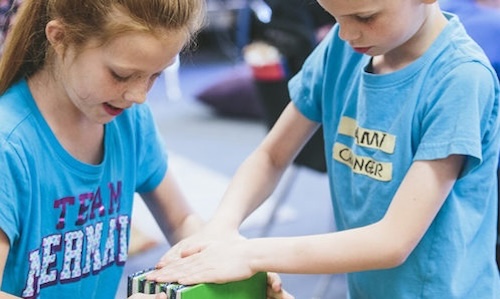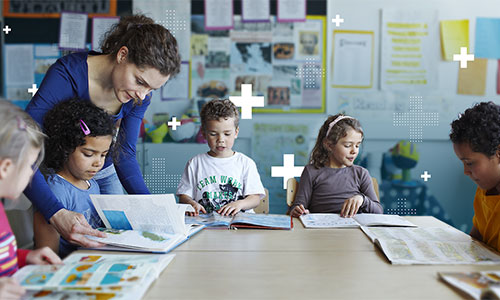
The science of reading is the converging evidence of what matters and what works in early literacy instruction. In previous posts, I’ve recapped what the evidence says about effectively supporting phonics and decoding, language comprehension, and fluency to help kids read increasingly complex text with understanding.
So if you’ve picked out your instructional and intervention approaches based on converging evidence in each of these areas, then you’re doing the science of reading, right? Not necessarily.
Making those initial selections is a great start, but the science of reading involves more doing than done-ing. The science of reading is not a multivitamin—take this and you’re good to grow! Instead, it involves active and iterative tending, observing, and adjusting. You need to continually do the science to ensure good growth.
Does “what works” always work the same? No.
If there’s one thing the past couple of years have taught us, it is that life throws us curveballs. Granted, I don’t know enough about baseball to be sure, but I think that means that sometimes when we swing the way the coach taught us to, the ball just doesn’t go where we planned. Circumstances matter.
It can be hard to ensure when we teach that we are even doing just what the coach described. When researchers investigate the effects of an intervention, they gauge fidelity: was what got implemented a good match to what was planned? Teachers don’t have that advantage. No one is there to check how well the way schools implement something matches what happened in studies.
And then there are all the ways that kids differ. Were the kids in the studies a different age or at a different stage in their literacy development than the ones in your classroom? Are your kids multilingual learners while the studies only focused on monolinguals? Were the kids in the study learning remotely or struggling to relearn how to learn together in person? Any of these differences could make a practice that was effective in research pan out differently in your real-life classroom.
Should you still use evidence-based practices? Yes.
Just because circumstances matter does not mean we should throw out the science of reading with the bathwater. I’m on Team Science because the science of reading works. Take it from a couple of star players on this team, Kymyona Burk and Maria Murray: “States that have adopted legislation around science-aligned approaches to reading instruction have seen significant improvements in reading achievement.”
Case in point: Mississippi. Remember when Mississippi was notoriously the worst-achieving state in reading? Now they have climbed out of the bottom altogether and are number one in growth on the National Assessment of Educational Progress (NAEP). How did they do it? One critical piece was comprehensive training of their K–3 teachers, both pre-service and in-service, in the science of reading.
It turns out that when we help more teachers to use evidence-based practices, we help more students read well.
You’ve got your evidence-based practices. Now what?
So maybe you’ve done your due diligence: you’ve chosen and learned to implement evidence-based practices in your literacy instruction. Welcome to the team! But remember: done-ing is not a thing. Here’s where we move to the doing part of the science of reading. This is where you become the scientist by collecting data and responding to it with instructional adjustments.
Scientists are always using observations to address a good question. You do science when you shift from “I taught that” to “Who successfully learned that?” Science is the shift from “I offer good instruction” to “How well is this resulting in good growth, and for whom?” A teacher’s science is an applied one—this is no cold, antiseptic lab, and those are no mice—so you are constantly using these observations to tweak and adjust what you do to maximize learning.
There are a few different ways people talk about use of observational data to inform instructional decisions. First, formative assessment practice calls for eliciting plenty of informal classroom learning data (anything from oral reading data to the kinds of questions students are asking), comparing that evidence to clear learning goals, and adapting and differentiating based on any needs that are revealed. If you can cultivate this kind of responsive teaching and learning cycle, that can significantly improve growth for students.
A second approach for using data to inform decisions is more tied to models like multi-tiered systems of support (MTSS) and response to intervention (RTI). These focus more on data from screening and benchmark assessments, progress monitoring, and skills diagnostic assessments. Using them involves making changes to the focus or intensity of instruction, either for whole groups or for individuals, based on more objective data. Check out the What Works Clearinghouse practice guide on using tiers of intervention for a deeper dive.
We have evidence that data-based decision-making can improve reading outcomes for readers needing extra support. But that doesn’t always happen. Note that back in 2015, there was evidence that many schools were not implementing schoolwide RTI models strongly. We can do better. That sobering finding was a critical reminder that if you aren’t using data to drive good instruction and targeted intervention, that data won’t cause any change on its own. If getting on the bathroom scale were enough to lose weight, we’d all be done dieting.
What does it look like to use data in the science of reading?
Data is for informing decisions that help improve teaching and learning. If no one is going to use the data from an assessment to improve real decisions, then that assessment is a waste of instructional time.
Consider how well you are connecting each kind of data you collect to a decision you are improving. Making this habit central to your teaching means stepping up to doing the science of reading. Here are four things to try.
- During a phonics lesson, ask all students to build a new word (“Change ‘sack’ to ‘stack’!”) on their own whiteboard. When you have everyone hold up their work, you will see at a glance if everyone’s with you or if you need to circle back.
- For students getting more intensive intervention targeting reading fluency, progress monitor on oral reading passages weekly. Plot your data against a goal line (or let MAP® Reading Fluency™ do this for you) to see if growth is trending strong or weak. Then hold steady with the intervention or add some additional intensity, depending on what you see.
- To gauge how well your new whole-class literacy instruction is working, look at aggregated data from fall to winter or winter to spring on growth assessments. With MAP® Growth™, you can compare student growth to norms so you have some context for how much growth to expect. If your kids aren’t quite where they should be, it’s time to find ways to improve. Are you incorporating reading fluency work in social studies learning yet? Can you point to your curriculum for systematic, explicit phonics instruction? How well are you enlisting family support for language comprehension in each student’s home language?
- Check out the What Works Clearinghouse guide “Using student achievement data to support instructional decision making” for more ideas.
Science of reading, meet the art of teaching
I started this article with a reminder: the science of reading is the converging evidence of what matters and what works when teaching kids to read with comprehension. If you are adopting practices that our evidence says are effective andyou are using data to watch for how these practices are affecting growth in your particular class, then you are doing the science of reading. You are a scientist.
But you should take off that lab coat before it gets dirty, because you are a special kind of scientist: a nurturing, garden-growing one, out there in the dirt with your tender little sprouts. You are caring and creative and responsive. You might, like Toad from Frog and Toad Together, occasionally sing to your plants, even if the evidence-based protocol doesn’t call for that, because art and science together are what great teachers are made of.
And guess what the evidence says? A great teacher is what matters and what works most of all.







